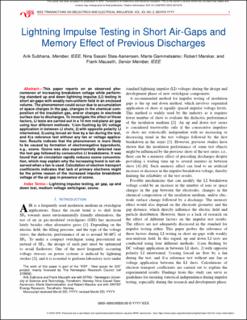| dc.contributor.author | Subhana, Arik | |
| dc.contributor.author | Støa-Aanensen, Nina Sasaki | |
| dc.contributor.author | Gammelsæter, Marte | |
| dc.contributor.author | Marskar, Robert | |
| dc.contributor.author | Mauseth, Frank | |
| dc.date.accessioned | 2024-04-24T08:09:55Z | |
| dc.date.available | 2024-04-24T08:09:55Z | |
| dc.date.created | 2024-03-07T12:57:51Z | |
| dc.date.issued | 2024 | |
| dc.identifier.issn | 1070-9878 | |
| dc.identifier.uri | https://hdl.handle.net/11250/3127857 | |
| dc.description.abstract | This paper reports on an observed phenomenon of increasing breakdown voltage while performing standard up and down lightning impulse (LI) testing in short air-gaps with weakly non-uniform field in an enclosed volume. The phenomenon could occur due to accumulation of space charges in the gap, changes in the chemical composition of the insulation gas, and/or changes in electrode surface due to discharges. To investigate the effect of these factors, LI tests are carried out in a 10 mm rod-plane air gap using four different methods: 1) ion flushing by DC voltage application in between LI shots, 2) with opposite polarity LI intertwined, 3) using forced air flow by a fan during the test, and 4) a reference test without any fan or voltage application. Results indicate that the phenomenon is more likely to be caused by formation of electronegative byproducts, e.g., ozone. Ozone was also experimentally detected near the test gap followed by consecutive LI breakdowns. It was found that air circulation rapidly reduces ozone concentration, which may explain why the increasing trend is not observed when a fan is used. Calculation of electron transport coefficients indicates that lack of primary electrons might be the prime reason of the increased impulse breakdown voltage of the air gap in presence of ozone. | en_US |
| dc.description.abstract | Lightning Impulse Testing in Short Air-Gaps and Memory Effect of Previous Discharges | en_US |
| dc.language.iso | eng | en_US |
| dc.publisher | IEEE | en_US |
| dc.rights | Navngivelse 4.0 Internasjonal | * |
| dc.rights.uri | http://creativecommons.org/licenses/by/4.0/deed.no | * |
| dc.title | Lightning Impulse Testing in Short Air-Gaps and Memory Effect of Previous Discharges | en_US |
| dc.title.alternative | Lightning Impulse Testing in Short Air-Gaps and Memory Effect of Previous Discharges | en_US |
| dc.type | Peer reviewed | en_US |
| dc.type | Journal article | en_US |
| dc.description.version | acceptedVersion | en_US |
| dc.source.journal | IEEE transactions on dielectrics and electrical insulation | en_US |
| dc.identifier.doi | 10.1109/TDEI.2024.3374276 | |
| dc.identifier.cristin | 2252784 | |
| dc.relation.project | Norges forskningsråd: 319930 | en_US |
| cristin.ispublished | true | |
| cristin.fulltext | preprint | |
| cristin.fulltext | preprint | |
| cristin.qualitycode | 1 | |

